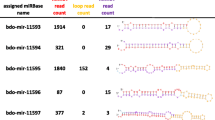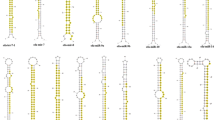Abstract
The rapid development of high-throughput next-generation sequencing approaches in recent years has facilitated large-scale discovery and expression analysis of non-coding RNAs, including miRNAs, in traditional and non-traditional animal models. Such an approach has been leveraged to amplify, identify, and quantify miRNAs in several models of cold adaptation. The present study is the first to investigate the status of these small RNAs in an insect species that uses the freeze avoidance strategy of cold hardiness, the gall moth Epiblema scudderiana. To characterize the overall miRNA expression profile and to identify cold-modulated miRNAs in control (5 °C) and cold-exposed (−15 °C) E. scudderiana larvae, a next-generation sequencing-based approach was undertaken. A total of 44 differentially expressed miRNAs were identified between the two conditions; 21 up-regulated miRNAs and 23 down-regulated miRNAs in −15 °C-exposed larvae as compared with controls. Among the most significant changes observed in miRNAs with potential relevance to cold adaptation were elevated miR-1-3p, miR-92b-3p, and miR-133-3p levels as well as reduced miR-13a-3p and miR-13b-3p levels in E. scudderiana larvae exposed to cold temperatures. Expression values obtained from next-generation sequencing were also validated by a quantitative PCR approach for five miRNAs; miR-34-5p, miR-274-5p, miR-275-3p, miR-307a-3p, and miR-316-5p. Overall, this work provides the first description of a miRNA signature for subzero survival by a freeze-avoiding insect using a high-throughput approach and positions a new group of miRNAs at the forefront of the molecular changes underlying cold adaptation.



Similar content being viewed by others
References
Kelleher MJ, Rickards J, Storey KB (1987) Strategies of freeze avoidance in larvae of the goldenrod gall moth, Epiblema scudderiana: laboratory investigations of temperature cues in the regulation of cold-hardiness. J Insect Physiol 33:581–586
Rickards J, Kelleher MJ, Storey KB (1987) Strategies of freeze avoidance in the larvae of the goldenrod gall moth, Epiblema scudderiana: winter profiles of a natural population. J Insect Physiol 33:443–450
McMullen DC, Ramnanan CJ, Storey KB (2010) In cold-hardy insects, seasonal, temperature, and reversible phosphorylation controls regulate sarco/endoplasmic reticulum Ca2+-ATPase (SERCA). Physiol Biochem Zool 83:677–686
Holden HA, Storey KB (2011) Reversible phosphorylation regulation of NADPH-linked polyol dehydrogenase in the freeze-avoiding gall moth, Epiblema scudderiana: role in glycerol metabolism. Arch Insect Biochem Physiol 77:32–44
McMullen DC, Storey KB (2008) Mitochondria of cold hardy insects: responses to cold and hypoxia assessed at enzymatic, mRNA and DNA levels. Insect Biochem Mol Biol 38:367–373
Bartel DP (2004) MicroRNAs: genomics, biogenesis, mechanism, and function. Cell 116:281–297
Friedman RC, Farh KK, Burge CB, Bartel DP (2009) Most mammalian mRNAs are conserved targets of microRNAs. Genome Res 19:92–105
Morin P Jr, Dubuc A, Storey KB (2008) Differential expression of microRNA species in organs of hibernating ground squirrels: a role in translational suppression during torpor. Biochim Biophys Acta 1779:628–633
Liu Y, Hu W, Wang H, Lu M, Shao C, Menzel C, Yan Z, Li Y, Zhao S, Khaitovich P, Liu M, Chen W, Barnes BM, Yan J (2010) Genomic analysis of miRNAs in an extreme mammalian hibernator, the Arctic ground squirrel. Physiol Genom 42A:39–51
Lyons PJ, Poitras JJ, Courteau LA, Storey KB, Morin P Jr (2013) Identification of differentially regulated microRNAs in cold-hardy insects. Cryo Lett 34:83–89
Chen B, Zhang B, Luo H, Yuan J, Skogerbø G, Chen R (2012) Distinct MicroRNA subcellular size and expression patterns in human cancer cells. Int J Cell Biol 2012:672462
Lau K, Lai KP, Bao JY, Zhang N, Tse A, Tong A, Li JW, Lok S, Kong RY, Lui WY, Wong A, Wu RS (2014) Identification and expression profiling of microRNAs in the brain, liver and gonads of marine medaka (Oryzias melastigma) and in response to hypoxia. PLoS One 9:e110698
Barrera-Figueroa BE, Gao L, Wu Z, Zhou X, Zhu J, Jin H, Liu R, Zhu JK (2012) High throughput sequencing reveals novel and abiotic stress-regulated microRNAs in the inflorescences of rice. BMC Plant Biol 12:132
Chen M, Zhang X, Liu J, Storey KB (2013) High-throughput sequencing reveals differential expression of miRNAs in intestine from sea cucumber during aestivation. PLoS One 8:e76120
Chen M, Storey KB (2014) Large-scale identification and comparative analysis of miRNA expression profile in the respiratory tree of the sea cucumber Apostichopus japonicus during aestivation. Mar Genom 13:39–44
Etebari K, Asgari S (2013) Conserved microRNA miR-8 blocks activation of the Toll pathway by upregulating serpin 27 transcripts. RNA Biol 10:1356–1364
Wen JZ, Liao JY, Zheng LL, Xu H, Yang JH, Guan DG, Zhang SM, Zhou H, Qu LH (2014) A contig-based strategy for the genome-wide discovery of microRNAs without complete genome resources. PLoS One 9:e88179
Hackenberg M, Sturm M, Langenberger D, Falcón-Pérez JM, Aransay AM (2009) miRanalyzer: a microRNA detection and analysis tool for next-generation sequencing experiments. Nucleic Acids Res 37:W68–W76
Etebari K, Asgari S (2014) Accuracy of microRNA discovery pipelines in non-model organisms using closely related species genomes. PLoS One 9:e84747
Robinson MD, McCarthy DJ, Smyth GK (2010) edgeR: a Bioconductor package for differential expression analysis of digital gene expression data. Bioinformatics 26:139–140
Biggar KK, Kornfeld SF, Storey KB (2011) Amplification and sequencing of mature microRNAs in uncharacterized animal models using stem-loop reverse transcription-polymerase chain reaction. Anal Biochem 416:231–233
Lang-Ouellette D, Morin P Jr (2014) Differential expression of miRNAs with metabolic implications in hibernating thirteen-lined ground squirrels, Ictidomys tridecemlineatus. Mol Cell Biochem 394:291–298
Andersen CL, Ledet-Jensen J, Ørntoft T (2004) Normalization of real-time quantitative RT-PCR data: a model based variance estimation approach to identify genes suited for normalization—applied to bladder- and colon-cancer data-sets. Cancer Res 64:5245–5250
Livak KJ, Schmittgen TD (2001) Analysis of relative gene expression data using real-time quantitative PCR and the 2(−delta delta C(T)) method. Methods 25:402–408
Jurka J, Kapitonov VV, Pavlicek A, Klonowski P, Kohany O, Walichiewicz J (2005) Repbase Update, a database of eukaryotic repetitive elements. Cytogenet Genome Res 110:462–467
Griffiths-Jones S, Bateman A, Marshall M, Khanna A, Eddy SR (2003) Rfam: an RNA family database. Nucleic Acids Res 31:439–441
Griffiths-Jones S, Saini HK, van Dongen S, Enright AJ (2008) miRBase: tools for microRNA genomics. Nucleic Acids Res 36:D154–D158
Courteau LA, Storey KB, Morin P Jr (2012) Differential expression of microRNA species in a freeze tolerant insect, Eurosta solidaginis. Cryobiology 65:210–214
Rubio M, Montanez R, Perez L, Milan M, Belles X (2013) Regulation of atrophin by both strands of the miR-8 precursor. Insect Biochem Mol Biol 43:1009–1014
Hyun S, Lee JH, Jin H, Nam J, Namkoong B, Lee G, Chung J, Kim VN (2009) Conserved microRNA miR-8/miR-200 and its target USH/FOG2 control growth by regulating PI3K. Cell 139:1096–1108
Kennell JA, Gerin I, MacDougald OA, Cadigan KM (2008) The microRNA miR-8 is a conserved negative regulator of Wnt signaling. Proc Natl Acad Sci USA 105:15417–15422
Volk N, Shomron N (2011) Versatility of MicroRNA biogenesis. PLoS One 6:e19391
Ho JJ, Metcalf JL, Yan MS, Turgeon PJ, Wang JJ, Chalsev M, Petruzziello-Pellegrini TN, Tsui AK, He JZ, Dhamko H, Man HS, Robb GB, Teh BT, Ohh M, Marsden PA (2012) Functional importance of Dicer protein in the adaptive cellular response to hypoxia. J Biol Chem 287:29003–29020
Ruby JG, Stark A, Johnston WK, Kellis M, Bartel DP, Lai EC (2007) Evolution, biogenesis, expression, and target predictions of a substantially expanded set of Drosophila microRNAs. Genome Res 17:1850–1864
Dutta S, Baehrecke EH (2008) Warts is required for PI3K-regulated growth arrest, autophagy, and autophagic cell death in Drosophila. Curr Biol 18:1466–1475
Wu CW, Storey KB (2012) Regulation of the mTOR signaling network in hibernating thirteen-lined ground squirrels. J Exp Biol 215:1720–1727
Zhang J, Storey KB (2013) Akt signaling and freezing survival in the wood frog, Rana sylvatica. Biochim Biophys Acta 1830:4828–4837
Chen Z, Liang S, Zhao Y, Han Z (2012) miR-92b regulates Mef2 levels through a negative-feedback circuit during Drosophila muscle development. Development 139:3543–3552
Li Y, Li L, Guan Y, Liu X, Meng Q, Guo Q (2013) MiR-92b regulates the cell growth, cisplatin chemosensitivity of A549 non-small cell lung cancer cell line and target PTEN. Biochem Biophys Res Commun 440:604–610
Zhang X, Zheng Y, Cao X, Ren R, Yo X, Jiang H (2014) Identification and profiling of Manduca sexta microRNAs and their possible roles in regulating specific transcripts in fat body, hemocytes, and midgut. Insect Biochem Mol Biol 62:11–22
Zhang G, Storey JM, Storey KB (2011) Chaperone proteins and winter survival by a freeze tolerant insect. J Insect Physiol 57:1115–1122
Biggar KK, Kornfeld SF, Maistrovski Y, Storey KB (2012) MicroRNA regulation in extreme environments: differential expression of microRNAs in the intertidal snail Littorina littorea during extended periods of freezing and anoxia. Genom Proteom Bioinform 10:302–309
Lyons PJ, Lang-Ouellette D, Morin P Jr (2013) CryomiRs: towards the identification of a cold-associated family of microRNAs. Comp Biochem Physiol Part D 8:358–364
Wu CW, Biggar KK, Storey KB (2013) Dehydration mediated microRNA response in the African clawed frog Xenopus laevis. Gene 529:269–275
Baldwin J, Aleksiuk M (1973) Adaptation of enzymes of temperature: lactate and malate dehydrogenases from platypus and echidna. Comp Biochem Physiol Part B 44:363–370
Olsson SO (1975) Comparative studies on the temperature dependence of lactic and malic dehydrogenase from a homeotherm, guinea pig (Cavia porcellus); two hibernators, hedgehog (Erinaceus europaeus) and bat (Nyctalus noctula); and two poikilotherms, frog (Rana temporaria) and cod (Gadus callarias). Comp Biochem Physiol Part B 15:5–18
Zhang W, Cohen SM (2013) The Hippo pathway acts via p53 and microRNAs to control proliferation and proapoptotic gene expression during tissue growth. Biol Open 2:822–828
Lozano J, Montañez R, Belles X (2015) MiR-2 family regulates insect metamorphosis by controlling the juvenile hormone signaling pathway. Proc Natl Acad Sci USA 112:3740–3745
Fleck CC, Carey HV (2005) Modulation of apoptotic pathways in intestinal mucosa during hibernation. Am J Physiol Regul Integr Comp Physiol 289:R586–R595
Rouble AN, Hefler J, Mamady H, Storey KB, Tessier SN (2013) Anti-apoptotic signaling as a cytoprotective mechanism in mammalian hibernation. PeerJ 1:e29
Ramnanan CJ, Groom AG, Storey KB (2007) Akt and its downstream targets play key roles in mediating dormancy in land snails. Comp Biochem Physiol B 148:245–255
Acknowledgments
We thank J. M. Storey for editorial review of the manuscript. This work was supported by a Discovery Grant from the Natural Sciences and Engineering Research Council of Canada (RGPIN/402222-2012) awarded to P. J. M.
Author information
Authors and Affiliations
Corresponding author
Rights and permissions
About this article
Cite this article
Lyons, P.J., Crapoulet, N., Storey, K.B. et al. Identification and profiling of miRNAs in the freeze-avoiding gall moth Epiblema scudderiana via next-generation sequencing. Mol Cell Biochem 410, 155–163 (2015). https://doi.org/10.1007/s11010-015-2547-3
Received:
Accepted:
Published:
Issue Date:
DOI: https://doi.org/10.1007/s11010-015-2547-3




